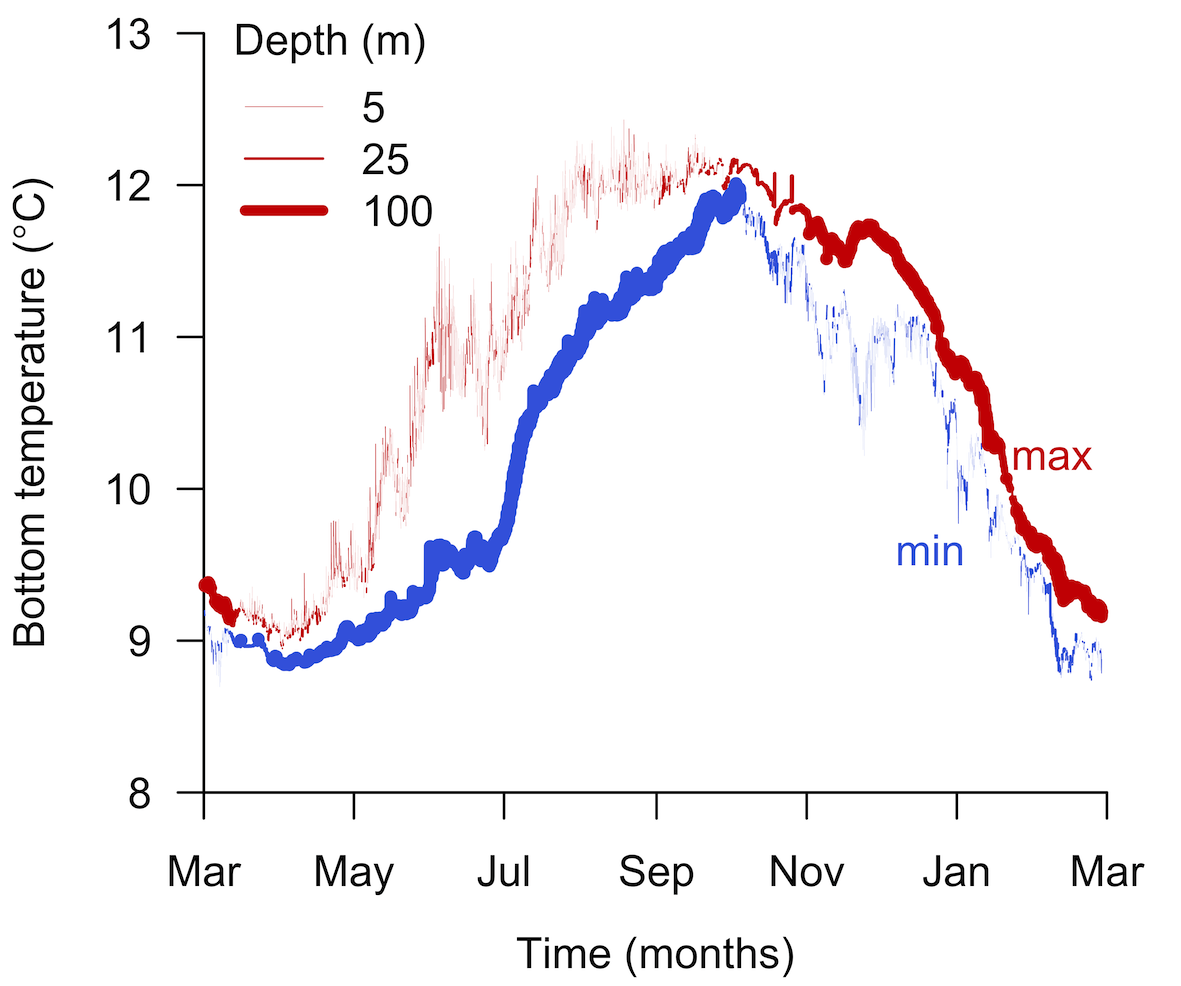Edward Lavender1,2*
1 Centre for Research into Ecological and Environmental
Modelling, University of St Andrews, Scotland
2 Scottish Oceans Institute, University of St Andrews,
Scotland
* This repository is maintained by Edward Lavender (el72@st-andrews.ac.uk).
This repository contains methods, written in R and organised as an R Project, for the exploration of flapper skate (Dipturus intermedius)
egg count–area scaling relationships and hydrodynamic conditions in the
Red Rocks and Longay Marine Protected Area (MPA). These methods support
Dodd et al. (2022). First report of an egg nursery for the Critically
Endangered flapper skate Dipturus intermedius (Rajiformes: Rajidae).
Aquatic Conservation: Marine and Freshwater Ecosystems, 32(10),
1647–1659. https://doi.org/10.1002/aqc.3857.
Hydrodynamic conditions across the MPA at large and in locations where eggs were found specifically were explored using the West Scotland Coastal Ocean Modelling System (WeStCOMS) (Aleynik et al., 2016). This modelling system resolves hourly hydrodynamic conditions across an unstructured, triangular mesh that is organised into 11 vertically spaced, terrain-following Sigma layers (the 1st layer lies at the surface, the 10th layer lies at the seabed and 11th layer lies below the seabed). Scalar variables, such as temperature, are resolved at mesh nodes, while vector variables, including current velocity vectors, are resolved at mesh centroids (elements). In this study, model predictions from a one-year period were used to analyse hydrodynamic conditions via the fvcom.tbx R package (Lavender, 2020).
For the MPA at large, two analyses were implemented:
- Current speed. The mean current speed and the range predicted for the area were calculated from hourly current velocity vector predictions for the deepest elements (approximately 5–20 m above the seabed, depending on location) over the analysed period.
- Temperatures. Spatiotemporal variation in bottom temperatures was explored using hourly temperature predictions for the 10th Sigma layer over the analysed period. Time series plot were used to visualise annual temperature trends and their relationship with depth.
For the WeStCOMS elements/nodes nearest to the stations in which eggs were located, near-bottom current speeds and temperature trends were examined in the same way in relation to conditions across the MPA at large.
For the sites with eggs, data on egg counts were also used to examine egg count–area scaling relationships and to estimate the area expected to contain different numbers of eggs. These analyses will guide the identification of further flapper skate egg nurseries in the future.
data-raw/contains ‘raw’ data for the project:eggs/contains egg survey data; namely:RR&L - locations where eggs were found and depth.xlsx, sourced from Jane Dodd;egg_counts.xlsx, assembled from data sourced from Jane Dodd;
spatial/contains spatial data; namely:coast/contains coastline data for the region, sourced from the Database of Global Administrative Areas;mesh/contains WeStCOMS mesh files, sourced from Dmitry Aleynik at the Scottish Association for Marine Science (SAMS);mpa/contains a shapefile of the MPA boundaries, sourced from NatureScot;
- WeStCOMS model predictions are also required for this project.
Local files are stored externally, but can also be obtained from
the SAMS Thredds
Server;
data/contains processed data and results:spatial/contains processed spatial data (fromprocess_data_raw.R);wc/contains results, fromanalyse_*Rscripts (see below);
R/contains scripts for data processing and analysis:define_global_param.Rdefines global parameters;process_data_raw.Rprocesses raw data;analyse_current.Ranalyses current velocities;analyse_temp.Ranalyses bottom temperatures;analyse_eggs.Ranalyses egg count–area scaling relationships;
fig/contains figures.
Note that the data-raw, data and fig directories are not provided
in the online version of this repository.
-
Define global parameters via
define_global_param.R. -
Process raw data via
process_data_raw.R. -
Implement WeStCOMS analysis via
analyse_current.Randanalyse_temp.R. -
Implement egg-counts analysis via
analyse_eggs.R.
Figure 1. Example outputs from the red_rocks_westcoms project: trends
in the minimum and maximum predicted hourly bottom temperature though
time and with depth across the WeStCOMS mesh in the Red Rocks and Longay
Marine Protected Area. The red line shows the maximum temperature and
the blue line shows the minimum temperature. Line thickness is
proportional to the depth of the seabed at the WeStCOMS node in which
the minimum/maximum temperature was predicted.
This repository uses a number of non-default packages, available from
The Comprehensive R Archive Network. These
can be installed with install.packages(). Four packages that are only
available on GitHub are also used:
fvcom.tbx. This package is used for WeStCOMS analyses.flapper. This package is used for parallelisation routines.prettyGraphics. This package is used for plotting.utils.add. This package is used for summarising data.
Aleynik, D. et al. (2016). A high resolution hydrodynamic model system suitable for novel harmful algal bloom modelling in areas of complex coastline and topography. Harmful Algae, 53, 102–117. doi:10.1016/j.hal.2015.11.012.
Dodd, et al. (2022). First report of an egg nursery for the Critically Endangered flapper skate Dipturus intermedius (Rajiformes: Rajidae). Aquatic Conservation: Marine and Freshwater Ecosystems, 32(10), 1647–1659. https://doi.org/10.1002/aqc.3857.
Lavender, E. (2020). fvcom.tbx: An R toolbox for the unstructured grid Finite Volume Community Ocean Model (FVCOM). R package version 0.1.0. Available at: https://github.com/edwardlavender/fvcom.tbx.

